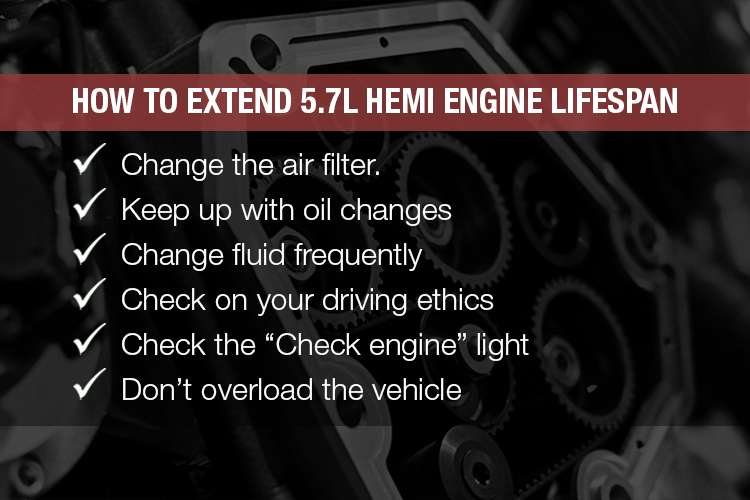The 5.7L Hemi engine has been among the most popular gasoline engines for all good reasons. Since its release in 2003, it has constantly proven itself to be reliable and robust. One of the commonly asked questions is on the longevity of the engine in service.
Are you wondering what the peak mileage of a 5.7L Hemi Engine is? Are you in the market for a used 5.7L Hemi and want to know how many miles you have left?
If yes, then this article has all the information you need. Stay tuned!
What is the 5.7L Hemi Engine?
Chrysler first released the 5.7L Hemi in 2003 as part of the third generation Hemi Engine family. The V8 debuted in the Dodge Ram pickup, producing 345 HP and 375 ft-lb of torque. It came as a replacement to the 5.9L Magnum and had a hemispherical combustion chamber. This allows for bigger valves and a more efficient spark plug placement for maximum power output.
The 5.7L Hemi has been considered one of the most robust gasoline engines. As a result, it has gained popularity among several sports car models.
The 5.7L Hemi was available in:
- 2004 Dodge Ram
- 2004 Dodge Durango
- 2005 Chrysler 300C
- 2005 Dodge Magnum R/T
- 2005-Jeep Grand Cherokee
- 2006 Jeep Commander
- 2006 Dodge Charger R/T
- 2007 Chrysler Aspen
- 2009 Dodge Challenger R/T
- 2022 Jeep Wagoneer
Cylinder deactivation is not included in manual transmission vehicles (3/4 and 1-ton and challenger pickups)
What is the 5.7L Hemi Longevity?
The average lifespan of the 5.7L Hemi is 250,000 to 300,000 miles. However, the engine pays back a good number of miles under proper care and maintenance. Early models of the 5.7L Hemi had valve seat issues, but Chrysler rectified that after 2008.
How to extend the 5.7L Hemi Engine lifespan
As stated earlier, the average lifespan of the 5.7L Hemi is 250-300K Miles. Nevertheless, frequent maintenance and proper engine care are crucial in extending the lifespan of the 5.7L Hemi.
Here are some tips on how to extend the 5.7L Hemi engine.

Change the air filter
A clogged air filter will limit air intake in the combustion chambers of the engine block. Since oxygen is crucial in combustion, the engine makes up for the same by burning more gasoline. That results in an abnormal rise in operating temperatures that significantly reduce the engine’s life span.
Keep up with oil changes
Oil cools and lubricates the tightly-packed parts of your engine. Foregoing regular oil changes bring about friction in the crucial engine parts and eventual engine failure. It is advised that you change the oil every 3,000 miles.
Check on your driving ethics
Frequent hitting of maximum speeds overworks your engine, causing it to overheat. Moreover, hard stops and sudden acceleration bring about abrupt changes that cause stress to the engine block.
On the other hand, driving at average speeds maintains a healthy balance of operation in the engine block and rarely overheats.
Therefore, it is advised that you maintain good driving ethics to increase your engine’s lifespan.
Change fluid regularly
Other fluids require attention apart from the engine oil. The likes of brake fluid, transmission fluid, radiator coolant, and power steering fluid all need changing after a couple of weeks. Checking your fluid levels and condition is essential as the fluids also help dissipate heat from the engine block. By that, you will have insured your engine from damage by overheating and extended its lifespan.
Check your “check engine” light
Most drivers tend to ignore the “check engine” light when it turns on. Moreover, some may deny attending to strange noises and emissions from the engine to realize an underlying problem. It is advised that you visit a checkup centre to have your engine checked if the “check engine” light pops up.
Don’t overload the vehicle
Every car comes with a pre-set towing and payload capacity. Smaller cars are mainly designed to handle lesser weights than large trucks and SUVs. Therefore, overloading your car stresses the engine and leads to premature engine failure. It is advised that you first consult with your user’s manual to determine the maximum amount of weight your car can tow or carry.
Above all, regular engine checkups are vital to ensure consistency in your engine’s health. Don’t wait for the “check engine” light to pop up. Repair now is cheaper than repair later.
FAQs
1. What fuel is recommended for a 5.7L Hemi?
87-93 Octane. For peak performance, Chrysler recommends 89 Octane. It is also acceptable to use the 87 Octane in the Hemi 5.7L. However, some users have reported using 91-93 Octane, proving that a higher Octane is not harmful to your 5.7L Hemi Engine.
2. How much does it cost to replace a 5.7L Hemi engine?
Anything between $2,900 and $13,000. A remanufactured Hemi Engine costs an average of $2,900 to $4,000 before having a professional install it. A new one will cost you around $8,000. Installation cost will hike the price up to around $13,000.
Used 5.7L Hemi engines might cost as low as $1,000 but will require more labor and modifications.
3. What is the best year 5.7L Hemi?
2009. Chrysler released the 5.7L ‘Eagle,’ which was an upgraded version of the 5.7L Hemi engine. It came with significant changes to improve its stability and efficiency. In addition, one of the most significant improvements was the implementation of VVT (Variable Valve Timing). VVT came with an extended front cam bearing and three additional oil passages in the block. There are reinforced connecting rods, new pistons, and a dual-mass crankshaft damper for now narrower ring pack. From 2009 onwards, some 5.7L Hemi engines feature an electronically controlled intake runner of variable length.
Conclusion
The 5.7L Hemi engine’s hemispherical design allows for more combustion and output. As a result, the engine has become a favorite sighting in modern sports cars and SUVs that need tons of power to keep moving. It has a generous lifespan of 250,000-300,000 miles, which might increase with proper care and maintenance.




